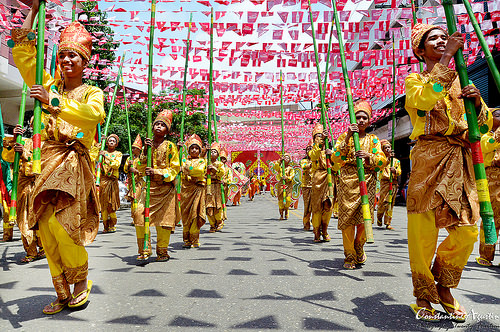Festival Hop Around the Philippines
written on February 15th, 2016 by Rafia Abubakar
How was your Sinulog festival to start the year? Can’t wait to do it all over again? You should try checking out the many other Philippine festivals. After all, the Philippines is home to colourful festivals happening all year round in different parts of the country. It is part of our culture and heritage.
The good news? There’s at least one festival almost every month. So start marking your calendars, and see where your next festivity will take you.
January
- It’s mentioned above, but it is worth reiterating. Sinulog happens every third Sunday of January in Cebu City. Famous for the colourful parade, street parties and the celebration of the Sto. Nino, attendance has grown every year and has turned into the biggest festival in the Philippines with millions in attendance.
- Dinagyang in Iloilo City. Another one of the many festivals celebrated to show reverence of Sto. Nino.
- Ati-Atihan in Kalibo, Aklan. Also happening on the 3rd Sunday of January. This is one of the festivals that inspired the Sinulog in Cebu and Dinagyang in Iloilo. Also in celebration of the Sto. Nino, expect tribal dancing, music and indigenous costumes.
February
- Panagbenga Festival in Baguio City. Panagbenga means Blooming Flowers Festival, or alternatively ‘the season of bloom’. This is one of the more unique festivals in the country, as Baguio City comes alive with a parade of floats covered in colourful flowers and blooms. The festival is usually held during the first week of February.
March
- Pintados Festival in Passi, province of Iloilo. Taking place every 3rd week of March. This festival is a cultural-religious celebration. The locals paying tribute to the tattooed warriors from years before the Spaniards set foot in the country.
April
- Aliwan Festival in Pasay, Metro Manila. Happening during the last week of April, ‘Aliwan’ means ‘entertainment’, and with the country’s passion for festivals it’s no wonder the Aliwan Festival came about. Dubbed the ‘Mother of all festivals’, Aliwan brings the best of ALL Philippine fiestas together in one massive celebration of cultural diversity. A showcase of the best of the best in Float Parade, Beauty Pageants and of course Cultural Street Dance contest.
May
- Flores de Mayo or Santacruzan, Another one of the biggest festivals in the country, aptly nicknamed the Queen of Filipino Festivals, the Santacruzan is celebrated all over the country during the height of summer in May. This is the time when flowers bloom in bundles after the rains, and the Filipinos give praise and thanks to the Blessed Virgin Mary.
In most cities, a parade of the selected town beauties is done, with either floats or hand carried arches decorated with flowers.
- Pahiyas Festival in Lucban City, Quezon. Held during harvest time in May, Pahiyas, like many of the Philippine festivals celebrate and give thanks for a bountiful harvest.
At the core of this festival, is the celebration of a bountiful harvest.The festival is also celebrated to honor San Isidro Labrador, the patron saint of farmers. Flowers and fruits are also common decorative themes, found on the front porches of houses.
- Obando Fertility Rites in Bulacan. Usually on the second week of May, the Obando is an interesting festival. Stemming from an old traditional ritualistic fertility rite, the highlight of this event is the ritual dance childless couples participate in, in hopes of bearing a child.
August
- Kadayawan Festival in Davao. The feast is an annual thanksgiving celebration for abundant harvest, life, and nature. In old tradition, locals used to make offerings at the foot of Mt. Apo. In the local dialect, the word Madayaw means ‘a treasured thing’ or something of value. The festival takes its name from this word, fully expressing the locals thanksgiving for another year of good harvest.
September
- Tuna Festival in General Santos City. Happening on the first week of September, General Santos City comes alive in celebration of their top international grade Tuna. The city is ‘Philippines’ Tuna Capital’, thanks to the steady supply of fresh tuna. Being recognized as a global source for tuna, it’s no wonder that the city celebrates a festival in honor of its local product. If you’re looking to have your fill of tuna fish, then this is the festival for you.
October
- Masskara Festival in Bacolod City. This festival was born out of a need to alleviate the locals’ morale during a global market crisis in sugar that hit the city’s main crop. The city’s administration decided to hold a ‘smiling festival’. Bringing together the locals to push beyond the crisis. ‘Smiling masks’ became a common decor to show unity in this festival.
November
- Higantes Festival in Angono, Rizal. The festival is held on the 3rd week of November. The name itself higantes (which means ‘giants’) explains the festival best. The highlight is the parade of towering giants. Traditionally made out of paper-mache, the giants are designed to convey a person’s character or a concept. Though originally, the practice was born out of locals making fun of a very mean landlord.
December
- Giant Lantern Festival in San Fernando, Pampanga. On the Saturday just before Christmas Eve the Giant Lantern Festival is a yearly festival celebrated in December.
The festival features a contest of the brightest and prettiest giant lanterns, with emphasis to grand structure. Originally the festival had its roots in Bacoor. It later transferred to San Fernando at the start of the 20th century. Lanterns come up to almost-sixteen feet. Some have even seen upgrades with the inclusion of lights and sounds in their elaborate designs.
Filipinos are known for their love of fiestas and celebration. It’s no wonder that apart from those mentioned above, you may likely stumble upon all kinds of festivities in your travel in the Philippines.
Most of the festivals are religious in origin. That’s why most of them are thanksgiving or a reverence to a patron saint. But this doesn’t mean Filipinos don’t have fun. If you see the colourful banderitas hanging above the streets, the sounds of drums and lyres in the distance, you’re in for a treat.








